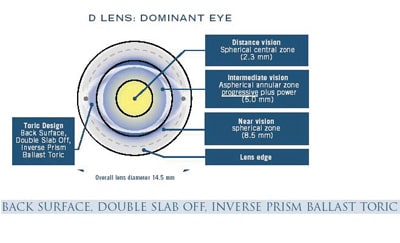prescribing for astigmatism
Fitting
Success with a Soft Toric Multifocal Lens
Although dozens of soft toric multifocal designs have surfaced over the past several years, none has emerged as an obvious leader. But finally, we appear to have a real contender with the UltraVue 2000T multifocal toric (CooperVision). Based on Cooper's "Balance Progressive Technology" that the company also uses in its spherical Frequency 55 and Proclear multifocal designs, the 2000T incorporates a back-surface cylinder to provide astigmatic correction for presbyopes.
|
|
|
|
|
|

|
Design Mechanics
The balance progressive technology consists of two front-surface designs: A "D" (distance or dominant) lens and an "N" (near or nondominant) lens. This approach has a monovision aspect, but the effect is all multifocal. The D lens design features distance correction at its center, surrounded by a progressive intermediate, which is encircled by a spherical near correction. The N lens design follows an opposite pattern with near correction at the center, surrounded by a negative progressive zone and spherical distance zone (See figures above).
Although you choose one eye for the D lens and the other for the N lens, both lenses are multifocal and it's common for patients to have good monocular acuities in either or both eyes.
The UltraVue 2000T is a logical extension of this design, incorporating prism stabilization and cylindrical correction. Currently this lens is available only on a made-to-order basis, although generous available parameters balance this disadvantage. The standard diameter is 14.5mm. Base curves include 8.3mm, 8.6mm or 8.9mm. Sphere powers are available from +8.00D to –8.00D. Cylinder powers range from –0.75D to –3.75D at any axis, and add powers range from +1.00D to +4.00D.
The lens is currently made from hioxifilcon B (Group I, 49 percent water) and falls under the conventional hydrogel lens category. It's compatible with any modern lens care system.
Lens Fitting
Because the multifocal
design of the UltraVue 2000T is the same as that of the Frequency 55 and Proclear
multifocals, it's possible to attain acceptable fit and visual acuity using the
spherical trial lenses with cylinder over-correction in a trial frame. CooperVision
fully warrants the lens, so another alternative is to order the first pair empirically and then adjust
the parameters from there as needed.
Dr.
Bergenske,
a past chair of the American Academy of Optometry's Section on Cornea and Contact
Lenses, has practiced for over 20 years in Wisconsin and now is on the faculty at
Pacific University College of Optometry. E-mail him at: berg1101@pacificu.edu.




